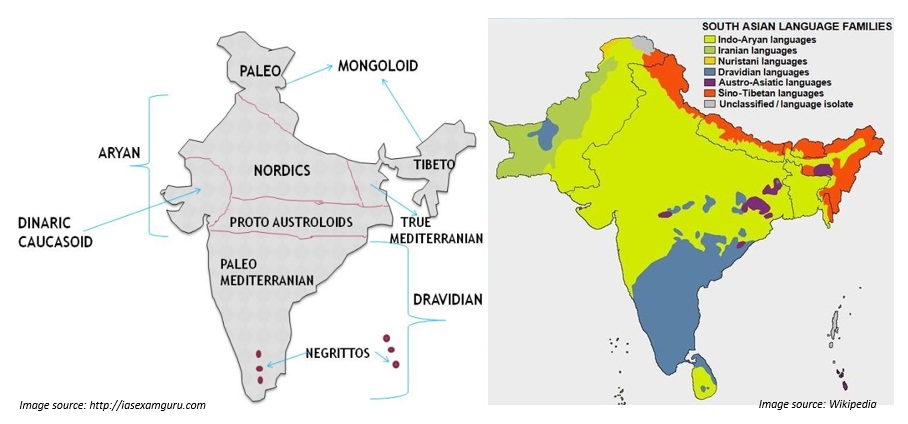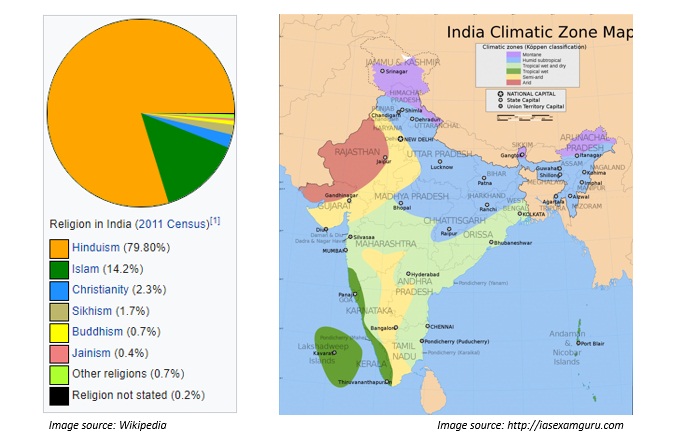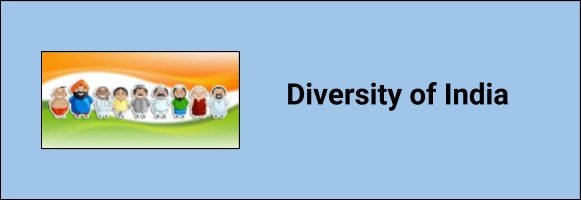(HOT) UPSC Current Affairs 2025 PDF
NEW! The Gist (NOV-2025) | E-BOOKS
Diversity of India : Important Topics for UPSC Exams
Diversity of India : Important Topics for UPSC Exams
India is known across world for its diversity. It is home to largest number of different socio-cultural groups based on race, religion, language etc. When India got independence, many political thinkers had commented that democracy in India will not survive because it’s too diverse to be united as a single nation. However they have been subsequently proved wrong. What distinguishes India from other diverse nations is its unity that has stayed despite various conflicts that exist in the society.
Basis of diversity and its distribution
Language
It is the most prominent feature of India’s diversity and in past has been a major source of unrest. There are more than 1600 languages spoken in India as recorded by 1961 census. Of then 22 are the official languages have been recognized as official languages under 8th schedule and about 197 are endangered. Indian languages are broadly classified under the following families:
-
Indo-Aryan language family: Languages like Hindi, Sanskrit, Urdu, Bengali, Kashmiri, Marathi etc. are part of this family and are spoken in most of the part of North India
-
Dravidian language family: Malayalam, Kannada, Tamil and Telugu are the prominent languages under this family spoken in the southern states
-
Austroasiatic language family: most of the tribal languages spoken in Chattisgarh, Jharkhand, Odisha are part of this family e.g. Khasi, Santhali, Meitei
-
Sino-Tibetan language family: Languages of the north-eastern state like Assamese, Manipuri, Bodo etc. constitute this family
-
Ohers: Other languages like Andamanese, Sentinelese are restricted to small number of speakers and therefore face extinction
Language has been the major issue of conflict in the past like:
-
Demands for state reorganization after independence based on languages – finally accepted through State reorganization act 1956
-
Dravidian and anti-hindi movements against the imposition of Hindi as the official language and in schools under the 3 language formula
-
Recently, it was the basis for Gorkhaland agitation

Buy Printed Complete Study Materials for UPSC IAS PRELIMS Exam
Online Crash Course for UPSC PRE Exam
Race
Following are the major racial groups of India and are distributed as shown in the map:
-
Negrito: found in the tribes of Andaman and Nicobar Islands
-
Proto-Australoids: Found mostly in the hills and forested tracts of central and southern India
-
Mongoloids: Located in the hilly tribes of North-East India, Sikkim and Ladakh.
-
Aryans: occupy the northern states
-
Dravidians: occupy the southern states
Racial discrimination is commonplace sight in India. While people from north-east are the common victims, discrimination against south Indians in north and vice-versa can also be seen.
Religion
The distribution of Indian population as per religion is as shown in the image below. Many of the states have Hindu majority but 7 states/UTs have Hindus in minority. Though Indian state is secular in character, India has been witness to many large scale communal riots since independence.

Geography
India is divided into 5 major climatic groups (shown in the image above) based on moisture and temperature. Monsoon acts as the binding thread for India since it is the main source of irrigation for agriculture. This geographic diversity then becomes the basis for diversity in festivals, cuisines, dresses, handicrafts, art etc.
For instance, since Jharkhand, Chhattisgarh, Western Ghats etc. have dense forests, they have predominantly a tribal culture as distinct from their contiguous areas. Ladakh separated from Jammu and Kashmir by Himalayan ranges has Buddhist majority and economy based on animal rearing in contrast to Hindu/Muslim dominated agrarian society in other areas.
Caste
The Hindu society in India is divided based on the caste system, a successor of the simpler varna system. This has been source of division and separation within the Hindu community leading to emergence of diverse cultural groups within the Hindu religion. Thus deities, food, attire and festivals differ across the caste groups. The system is sustained through endogamy which disallows a person to marry outside the caste thus maintaining the perfect silos.
Reasons of diversity in India:
-
Historically there has been mixing of the different religions, languages and ethnicities due to invasion by foreigners who settled here like Mughals, trade (Silk Road passing through Ladakh), pilgrimage (major Buddhist sites in India) and travelers like Ibn Battuta, Hiuen Tsang etc.
-
Geographical divisions like Vindhya and Satpura range in India, Himalayas in the north and northeast ensure that societies across these divisions developed their unique identity by limiting their mixing e.g. Aryan-Dravidian divide
-
Availability of the dense and isolated forests ensured growth of tribal culture as distinct from the mainstream society
-
Since India had been divided into small kingdoms since the early time, many local languages and distinctive culture has developed under the patronage of their rulers e.g. Malayan under Cheras and Bengali under Palas
Advantages of diversity:
-
It helps in strengthening love and tolerance promoting amity and unity and openness to other diverging views
-
It is the identity that India had asserted for long in three international foras
-
Diversity of culture translates into diversity of ideas and innovations
-
The rich heritage and culture resultant of this diversity has enormous potential for tourism capable of creating large scale employment
-
Geographical diversity creates rich reserve of flora and fauna benefiting the environment, tourism, pharmaceutical etc.
Disadvantages:
-
The social tension and conflicts arising from this diversity leading to growth of divisive tendencies like communalism, regionalism, linguism etc. present a major that to the social fabric, economic development and survival of democracy
What has ensured Unity in diversity?
-
Historical factors have helped strengthen and sustain the values of mutual existence
-
Freedom movement united India politically (INC, press) and economically (railways, post) and created basis for social unity
-
Following provisions of constitution have helped rein in the divisive tendencies:
-
Fundamental rights (equality, against exploitation, religion, cultural and educational freedom, freedom of movement and residence)
-
Directive principle (provisions related to SC/ST, protection of Heritage, socio-economic justice, Panchayat etc.)
-
Fundamental duties (uphold and protect the sovereignty, unity and integrity, promote harmony and the spirit of common brotherhood)
-
Freedom of inter-state trade and commerce
-
Following government measures ensure unity and integrity:
-
Laws such as prevention on atrocities act, protection of civil rights act, forest rights act
-
Policy of reservation to ensure political and economic justice to the downtrodden
-
Schemes like standup India, Padho Pardesh, Nai Manzil etc. for minorities and oppressed sections
-
Events that celebrate this unity and diversity such as republic day parade, Bharat parv
-
Cultural schemes like Ek Bharat Sreshtha Bharat, HRIDAY, PRASAD etc.
-
-
Independent judiciary which has successfully reined in the divisive tendencies of the governments. For instance, SC upheld the validity of President's rule in UP in 1990s due to communal policies of the the govt.
Threats:
Disputes are inevitable in any diverse society and when not managed properly they can turn into conflict, threatening the very survival of society as was the case in Balkan Peninsula. Similarly Indian society faces following challenges which endanger its ‘unity in diversity’.
-
Communalism: the rising majoritarian tendencies such as call for a ‘Hindu rashtra’, cow vigilantism, love jihad claims against inter-religion marriages threaten the secular fabric of Indian society
-
Regionalism: the demands of new states and even secession based on language (gorkhaland, Dravidnaad), religion (khalistan), ethnicity (nagalim) continue to mar the unity and integrity of nation
-
Linguism: perceived threats to the local language and recent attempts the Fife Hindu on non-willing sections have in the past led to movements like Dravidian movement and can be seen in recent times as well such as Gokhaland and Bodoland movements
-
Casteism: caste oppression had continued for long time with scant attempts to challenge it until recently. With the opportunities provided by increasing literacy rate and economic reforms and excessive politicisation, caste identities are becoming more pronounced than before. While some use it to challenge the oppression they have faced (Bhima-koregaon), others use it to claim benefits of reservation (Jat, Patidar, Maratha)
-
Racism: discrimination against people of North-east, people of south in northern states and vice versa threatens a whole section of the society, dissipating discrimination into division
-
Separatist movements: The ongoing separatist movements in J&K and North-East along with Naxalism have for long and continue to pose significant risks to India’s unity.
How to ensure this unity?
A society based on justice, liberty, equality and fraternity only can stay united for long, especially society as diverse as India. As the Sachar committee report has pointed out, minorities continue to fare poorly in socio-economic indicators as compared to majority. Similar is the case with tribals and Dalits where high GDP growth has not translated into development and improvement in quality of life.
It is therefore necessary that principles espoused in directive principles are realised in spirit. Investments in the social sector including health and education, electoral reforms to keep out the divisive tendencies, providing for development needs of deprived sections such as tribals and Dalits, inclusive and equitable urbanization and curbing the majoritarian tendencies through appropriate legal measures is the only way forward to ensure a united and integrated India.
Model Questions :
Previous year mains questions:


